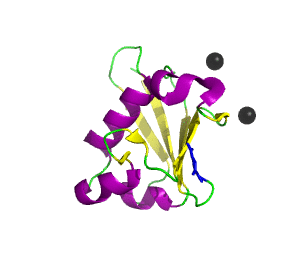
Protein primary structure is the linear sequence of amino acids in a peptide or protein. By convention, the primary structure of a protein is reported starting from the amino-terminal (N) end to the carboxyl-terminal (C) end. Protein biosynthesis is most commonly performed by ribosomes in cells. Peptides can also be synthesized in the laboratory. Protein primary structures can be directly sequenced, or inferred from DNA sequences.

Protein biosynthesis is a core biological process, occurring inside cells, balancing the loss of cellular proteins through the production of new proteins. Proteins perform a number of critical functions as enzymes, structural proteins or hormones. Protein synthesis is a very similar process for both prokaryotes and eukaryotes but there are some distinct differences.

In molecular biology, post-translational modification (PTM) is the covalent process of changing proteins following protein biosynthesis. PTMs may involve enzymes or occur spontaneously. Proteins are created by ribosomes, which translate mRNA into polypeptide chains, which may then change to form the mature protein product. PTMs are important components in cell signalling, as for example when prohormones are converted to hormones.
Mod, MOD or mods may refer to:
In linguistics, a modifier is an optional element in phrase structure or clause structure which modifies the meaning of another element in the structure. For instance, the adjective "red" acts as a modifier in the noun phrase "red ball", providing extra details about which particular ball is being referred to. Similarly, the adverb "quickly" acts as a modifier in the verb phrase "run quickly". Modification can be considered a high-level domain of the functions of language, on par with predication and reference.
The N-terminus (also known as the amino-terminus, NH2-terminus, N-terminal end or amine-terminus) is the start of a protein or polypeptide, referring to the free amine group (-NH2) located at the end of a polypeptide. Within a peptide, the amine group is bonded to the carboxylic group of another amino acid, making it a chain. That leaves a free carboxylic group at one end of the peptide, called the C-terminus, and a free amine group on the other end called the N-terminus. By convention, peptide sequences are written N-terminus to C-terminus, left to right (in LTR writing systems). This correlates the translation direction to the text direction, because when a protein is translated from messenger RNA, it is created from the N-terminus to the C-terminus, as amino acids are added to the carboxyl end of the protein.
Gmod or GMOD may refer to:
Chemical modification refers to a number of various processes involving the alteration of the chemical constitution or structure of molecules.
Alteration(s) may refer to:
A single-word modifier is one word that modifies the meaning of another word, phrase or clause.
In molecular biology, the BEN domain is a protein domain which is found in diverse proteins including:

Ubiquitin-related modifier-1 (URM1) is a ubiquitin-like protein that modifies proteins in the yeast ubiquitin-like urmylation pathway. Structural comparisons and phylogenetic analysis of the ubiquitin superfamily has indicated that Urm1 has the most conserved structural and sequence features of the common ancestor of the entire superfamily.
A nucleoside-modified messenger RNA (modRNA) is a synthetic messenger RNA (mRNA) in which some nucleosides are replaced by other naturally modified nucleosides or by synthetic nucleoside analogues. modRNA is used to induce the production of a desired protein in certain cells. An important application is the development of mRNA vaccines, of which the first authorized were COVID-19 vaccines.
This page is based on this
Wikipedia article Text is available under the
CC BY-SA 4.0 license; additional terms may apply.
Images, videos and audio are available under their respective licenses.



